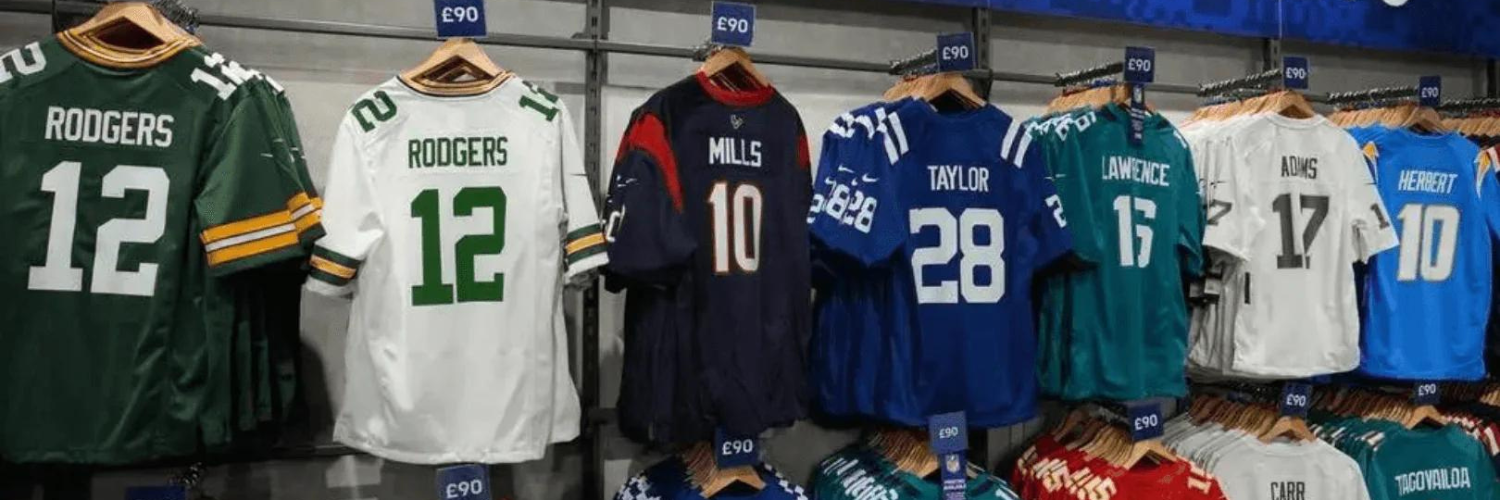Jersey Sponsorships Explained: Will the NFL Introduce Jersey Patch Sponsors?
Revenue streams have evolved beyond ticket sales and broadcasting rights to include lucrative commercial opportunities. One such avenue that has gained prominence in recent years is jersey sponsorships.
These partnerships between sports teams and corporate entities have become a significant source of income for teams and an effective marketing platform for sponsors. In this article, we will delve into what jersey sponsorships are, who they benefit, and the intricate mechanisms behind the financial gains associated with these collaborations.
What Are Jersey Sponsorships?
Jersey sponsorships involve a corporate brand or company paying for the right to display their logo or name on a sports team’s uniform. This collaboration allows sponsors to gain visibility and exposure to a vast audience, while teams benefit from a new revenue stream that can contribute to player salaries, facility upgrades, and overall team development.
While common in soccer, where teams prominently feature sponsor logos on their jerseys, this practice has expanded across various sports, including basketball, baseball, and even esports.
Who Benefits from Jersey Sponsorships?
- Teams and Organizations:
The primary beneficiaries of jersey sponsorships are the sports teams themselves. In an era where financial sustainability is paramount, the injection of funds from sponsors enables teams to enhance their competitiveness. The revenue generated often goes towards improving training facilities, recruiting top-tier talent, and investing in cutting-edge technology to gain a competitive edge. - Players:
Jersey sponsorships indirectly benefit players as well. The increased revenue can lead to higher player salaries, improved facilities, and better overall support structures. This not only attracts top talent but also helps teams retain their star players, fostering a more competitive and compelling sporting environment. - Sponsors:
For sponsors, jersey sponsorships provide an invaluable platform for brand exposure. The logo on the team’s jersey becomes synonymous with the team itself, and every time a game is played or televised, the sponsor’s brand is prominently showcased to a global audience. This exposure helps build brand recognition, increase market reach, and establish a positive association with the team’s success.
RELATED: BEST-SELLING THROWBACK NFL JERSEYS
Jersey Sponsorship for the NFL
While many leagues already benefit from the utilization of jersey sponsorships, the NFL has yet to implement this revenue stream into its already massively successful business model. NFL licensing could be an avenue for businesses’ with the manufacturing experience to leverage player affinity with their brand.
NFL sponsorship revenue has been growing at a steady rate year over year, with last season slowing to 4% versus the 12% the year before. This could lead to seeking out growth opportunities for the NFL. Renting out jersey sponsorships could be the answer.
The NBA has seen success with their revenue stream and the NFL could soon follow suit.
MORE: IS OWNING A SPORTS TEAM EVEN PROFITABLE?
How Do Jersey Sponsorships Work ?
The Mechanics:
- Negotiation: Teams and potential sponsors negotiate the terms of the deal, including placement, size, and duration of the logo display, as well as the financial compensation.
- Contract: A formal agreement outlines the rights and obligations of both parties.
- Activation: Sponsors often go beyond just logo placement, using the partnership for marketing campaigns, fan engagement activities, and social media promotions.
How Money is Made from Jersey Sponsorships
- Contractual Agreements:
The cornerstone of jersey sponsorships lies in contractual agreements between teams and sponsors. These agreements typically involve a fixed monetary sum paid by the sponsor to the team for the right to display their logo on the jersey. The contract duration can vary, ranging from a single season to multi-year deals, depending on the negotiating parties. - Visibility and Exposure:
The value for sponsors is derived from the visibility and exposure their brand receives during games, both in the stadium and through media broadcasts. The more popular and successful a team, the greater the exposure for the sponsor. This visibility extends beyond match days to training sessions, press conferences, and promotional events, creating a continuous stream of brand exposure. - Merchandising Opportunities:
Jersey sponsorships also open up merchandising opportunities for both teams and sponsors. Fans often purchase replica jerseys with sponsor logos, contributing to additional revenue streams. Sponsors may collaborate with teams to create limited-edition merchandise, further capitalizing on the fanbase’s loyalty and passion for the team. - Digital and Social Media:
In the digital age, jersey sponsorships transcend traditional media. Social media platforms, team websites, and online content featuring players in jerseys with sponsor logos amplify the exposure. Sponsors benefit from the global reach of these platforms, leveraging the team’s online presence to engage with fans and potential customers worldwide. - Performance-Linked Bonuses:
In some cases, sponsors may incorporate performance-linked bonuses into their contracts. If a team achieves specific milestones, such as winning a championship or reaching a certain number of viewership, the sponsor may provide additional financial incentives. This not only aligns the sponsor’s success with the team’s performance but also motivates teams to excel on the field.
Conclusion
Jersey sponsorships have become an integral component of the modern sports landscape, creating a symbiotic relationship between teams and corporate entities. As teams and brand seek new ways to make more money, these partnerships continue to evolve, shaping the economic landscape of sports.

